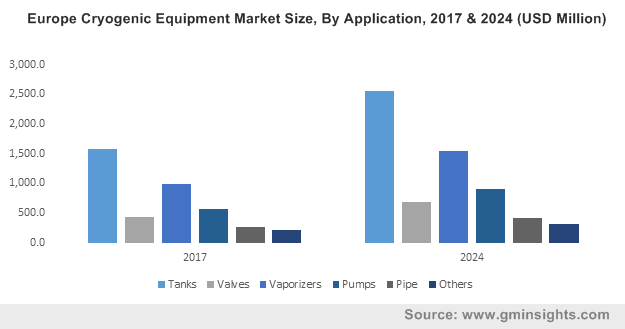Cryogenic equipment market to garner substantial proceeds from healthcare applications, escalating R&D activities to propel the industry demand
Publisher : Fractovia | Published Date : 2018-10-22Request Sample
Increasing awareness regarding new technologies in the industrial and healthcare sectors has proliferated the cryogenic equipment market, with worldwide earnings surpassing USD 15 billion in 2017. From the storage and distribution of industrial gases like nitrogen, oxygen, argon, helium and hydrogen to rubber and plastic deburring, cryogenics help to attain remarkable performance and cost-efficiency. The cryogenic equipment industry has also been able to carve out a sizable chunk from the healthcare segment globally, with applications such as storage of human cell, vaccinations and other biomaterials as well as for therapeutic uses. Continuous advancement in health tech and expansion of the medical services portfolio will create added opportunities for the cryogenic equipment market, as gradual increase in disposable income encourages the consumption of available services.
Europe Cryogenic Equipment Market Size, By Application, 2017 & 2024 (USD Million)

According to the U.S. Centers for Medicare and Medicaid Services (CMS), the healthcare spending in the country had reached USD 3.5 trillion in 2017 with a 4.6% rise as compared to the previous year. In 2015, spending in the healthcare sector was recorded to be EUR 338 billion in Germany alone, that became the highest spending country in Europe. The prevalence of chronic diseases, presence of appropriate heath insurance policies and the growing expenditure on medical facilities has simultaneously propelled the cryogenic equipment industry. Storing millions of dollars’ worth of biological products and life saving vaccines that are to be supplied across the world depend on proper storage facilities. Importance of preserving human cells and tissues have led to the establishment of hundreds of companies offering suitable healthcare services, driving demand for the cryogenic equipment market.
In hospitals and research organizations, the availability of cryogenic gases or liquids play a vital role in their functioning, as they are required to supply medical oxygen, cool the magnets in MRI machines, and during research on treatments for diseases like HIV. Innovative systems can deliver hospitals a reliable medical oxygen supply, besides helping them becoming independent of outside suppliers and strengthening the cryogenic equipment market. Programs initiated by governments and research organizations have propagated cutting-edge solutions developed for storing DNA and human tissues. Storage of stem cells has been gaining momentum over the last few years due to extensive medical advantages. Stem cells are proving to be vital in providing solutions for otherwise difficult to treat diseases that require regular blood transfusions and patients have to depend on donors.
To elaborate, storing cells, such as baby stem cells for later use avoids a situation of crisis for patients of the family and eliminates the time wasted in finding donors. The cryogenic equipment industry has been able to assist medical companies and professionals to implement long-term storage solutions for human cells, plasma and tissues for future use. Ongoing research activities are focusing on utilizing human cells for curing terminal illnesses, while many studies are concentrating on preserving endangered species through cryogenic storage of their bio samples. Development of effective vaccines & drugs to counter fatal diseases and epidemics also require ideal storage conditions to hold deadly viruses needed for research purposes. Statistics show that in 2016, the overall amount spent on health and medical research and development was around USD 171.8 billion and will keep increasing.
Major contributors for the healthcare R&D expense in the U.S. constitute healthcare service companies, medical technology firms and biopharmaceutical developers. A large amount of processes involved with these industries require low-cost and low-temperature distribution techniques, which also provide a non-reactive environment. With rising R&D budgets and more innovations being made in the healthcare segment, the cryogenic equipment market will generate commendable returns owing to unique offerings that allow researchers to carry out studies on different biomaterials. Innovative procedures like the cryotherapy are new to the world but present immense potential for growth. Studies have proven that cold therapy speeds up the process of recovery after physical workout and has been applied to athletes.
Dallas-based CryoUSA is a company that provides cryogenic chambers and claims that, after an athlete enters their unit, all the blood gets sent to the body’s core and the skin, tissues, and muscles are stripped of everything that causes pain and slows down body recovery. European researchers have also discovered similar results into cryotherapy, signifying a novel approach towards medical services and an emerging revenue source for the cryogenic equipment industry. Consistent developments in the healthcare segment that deliver such exceptional medical solutions will further propel the global cryogenics equipment market, which is estimated to record a 7% CAGR from 2018 to 2024.